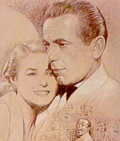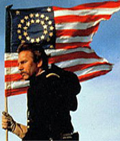Factual mistakes in The Amistad
- The Portuguese slave ship Tecora was one of the most notorious of the illegal slave ships, but no slaves were thrown overboard in mid-ocean as shown in the film - at least on the trip in question. The Portuguese were pros at the slave trade and had plenty of food on board to feed their "cargo" between Sierra Leone and Cuba. The only time a slave would be thrown overboard in mid-ocean was if his/her health posed a serious risk to the crew and "cargo". (Slaves were too valuable to just throw away for the price of their food.) Historically, though, there were instances where whole cargoes of slaves were tossed overboard. The British Royal Navy zealously patrolled the waters off West Africa to try to shut down the slave trade. If a British ship was sighted, the slavers sometimes tossed slaves overboard to destroy the evidence and prevent the seizure of the ship. 1
-
The central character, the enslaved Cinque, was not seized in Africa and then immediately exported to Cuba out of the slave depot at Lomboko. Cinque was enslaved a few years earlier by black Africans (a common practice) and eventually sold to slave traders.1
-
Cinque is shown in the first scene of the film ripping a nail (to pick his shackles) from the lower deck of Amistad with his bare and bloody fingers during a storm. In fact, Cinque was topside one day, and simply stooped down to pick up a piece of metal he saw to use as a pick. (Not quite as dramatic, but true.)1
-
Roger Baldwin was not a young, inexperienced "ambulance-chaser-type" lawyer. He was about 50 years old and very highly respected. A few years after the Amistad case, Baldwin was elected governor of the State of Connecticut.1
-
The film shows the slave depot at Lomboko destroyed by the Royal Navy after the Amistad trial. In fact, it was destroyed in 1839, shortly after Cinque was exported from there and long before the Amistad trial began in 1840.1
-
When President Van Buren enters the room at one point, "Hail to the Chief" is being played by the band. Although the song existed as early as 1812, it was not used ceremonially for the President until the 1840s.1
-
Cinque never met John Quincy Adams at his home and never had a discussion about African violets. African violets are native to East Africa, not Sierra Leone in the west. Cinque probably never saw an African violet in his entire life.1
-
At the end of the first trial when the judge said that the Africans are free, he also ordered the immediate arrest of Luis and Montez. According to historical records, they were not even in the country, much less present at the court proceedings. In fact, the Africans had already had them arrested on charges of assault and kidnap. They both paid bail and went back to Cuba.1
-
Until the U.S. Supreme Court's ruling, Cinque spent every day of his life in America locked up. He was not present for the Supreme Court's oral argument.1
-
No presidential candidate campaigned in person until William Jennings Bryan was nominated the Democratic candidate in 1896. Before Bryan, it was the practice that candidates campaign only in their hometown (candidates are to "stand" for office, not "run" for office) while their supporters campaign for them nation-wide.1
-
Most seriously, Amistad presents a highly misleading account of the case’s historical significance, in the process sugarcoating the relationship between the American judiciary and slavery. The film gives the distinct impression that the Supreme Court was convinced by Adams' plea to repudiate slavery in favor of the natural rights of man, thus taking a major step on the road to abolition.
In fact, the Amistad case revolved around the Atlantic slave trade — by 1840 outlawed by international
treaty — and had nothing whatever to do with slavery as an domestic institution. 2
-
"The film shows Van Buren making a whistlestop campaign for re-election. This is an anachronism; the nation's railway network was not sufficiently advanced in 1840 to allow such a tactic. It was also considered undignified for candidates to actively seek the presidency. Van Buren and his opponent, William Henry Harrison, allowed subordinates to do the work. "
-
"African-American historians have joined Foner in complaining about the creation of a fictional Theodore Joadson (Morgan Freeman) when historical black abolitionists such as the Reverend James W. C. Pennington, educator and missionary, actually participated in the Amistad affair."4
-
"According to the movie, President Van Buren (Nigel Hawthorne), realizing that the case at the lower court is turning against the interests of his Southern supporters whom he needs to win reelection, replaces Judge Andrew T. Judson, a principled old puffball, with a younger, more ambitious Democratic partisan, Judge Coglin (Jeremy Northam). Yet Coglin is an invention. In truth, Judge Judson, a Democratic party man and anti-abolitionist, relied on testimony from the famous Irish abolitionist Richard Robert Madden (not mentioned in the movie) to rule on the status of the Africans. "4
-
"In Amistad, President Van Buren stands in sharp contrast to his historical counterpart whose political acumen earned him the nickname “the Little Magician.” The movie portrays him as a rather dull, manipulable careerist. "4
-
"John Calhoun (Arliss Howard) strides into a White House dinner, svelte and dapper, looking remarkably fresh for a man who was actually approaching sixty at the time. He explicates Southern distinctiveness and the intertwining of the master and slave in the antebellum South. Yet he leaves his table companions—and the audience—with the grossly misleading notion that the weight of the Amistad case was such that a decision unfavorable to the South risked civil war. "4
-
The movie says that 7 of the nine justices were southern slaveholders. In fact, 5 were southerners and four of those were slave holders. In the movie all 7 were shown as being at the trial but only 5 were there. (needs to be verified)
1 From Moviemistakes.com
2 http://historymatters.gmu.edu/d/74, Eric Foner, The Amistad Case in Fact and Fiction, 1998.
3 http://en.wikipedia.org/wiki/Amistad_(1997_film), Wikipedia Article on The Amistad.
4 http://www.newcriterion.com/archive/16/mar98/amistad.htm, "From Hollywood to History", The New Criterion, 1998.
|

